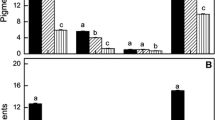Abstract
Experiments with sodium azide support the earlier report that two different photoreceptor systems participate in the absorption of the phototactically active light in Anabaena variabilis. The one of them, represented by the phycobili-proteins and chlorophyll a, is responsible for positive and negative phototaxis around 440 nm and between 580 and 700 nm. This system is sensitive to sodium azide which is able to reverse the negative reaction at high fluence rates to a positive one. The second one which absorbs light between 500 and 560 nm and above 700 nm is insensitive to azide. It triggers only negative responses in absence and presence of azide as well. P 750 is obviously not a photoreceptor pigment of this system, since there is no indication for its occurrence in Anabaena. Even photobleaching of the photosynthetic pigments at high fluence rates is prevented by azide. The noncyclic photosynthetic electron transport is not severely inhibited by azide because photokinesis is only in part impaired. Therefore, the hypothesis is suggested that the phototactic reaction-sign reversal generator of Anabaena is controlled by the level of an active oxygen species, probably singlet oxygen, which is quenched by azide.
Similar content being viewed by others
Abbreviations
- DCMU:
-
3-(3,4-dichlorophenyl)-1,1-dimethylurea
References
Abeliovich A, Shilo M (1972a) Photooxidative death in blue-green algae. J Bacteriol 111:682–689
Abeliovich A, Shilo M (1972b) Photooxidative reactions of c-Phycocyanin. Biochim Biophys Acta 283:483–491
Baulina OI, Suleymanova ShS, Mineyeva LA, Gusev MV (1981) The effect of high intensity light on the ultrastructure of blue-green algal cells under the conditions of photoautotrophic cultivation. Mikrobiologia 5:769–775
Carr NG, Komarek J, Whitton BA (1973) Notes on isolation and laboratory culture. In: Carr NG, Whitton BA (eds) Botanical monographs, vol 9. The biology of blue-green algae. Blackwell Scientific Publications, Oxford London Edinburgh Melbourne, pp 525–530
Drews G (1957) Die phototaktischen Reaktionen einiger Cyanophyceen. Ber Dtsch Bot Ges 70:259–262
Drews G (1959) Beiträge zur Kenntnis der phototaktischen Reaktionen der Cyanophyceen. Arch Protistenk 104:389–430
Famintzin A (1867) Die Wirkung des Lichtes auf Algen. Jb wiss Bot 6:1–44
Fischer K, Metzner H (1969) On chlorophyll and pigment 750 of Anacystis nidulans. In: Metzner P (ed) Progress in photosynthesis research, vol II. Laupp jr., Tübingen, pp 547–551
Foote CS, Denny RW (1968) Chemistry of singlet oxygen. VII. Quenching by β-carotene. J Am Chem Soc 90:6233–6235
Gassner EB (1962) On the pigment absorbing at 750 nm occurring in some blue-green algae. Plant Physiol 37:637–639
Govindjee C, Cederstrand C, Rabinowitch E (1961) Existence of absorption bands at 730–740 and 750–760 mμ in algae of different divisions. Science 134:391–392
Halliwell B (1977) The toxic action of oxygen on living organisms. In: Rehm HJ (ed) Biotechnologie. Verlag Chemie, Weinheim New York, pp 1–15
Hasty N, Merkel PB, Radlick P, Kearns DR (1972) Role of azide in singlet oxygen reactions: reaction of azide with singlet oxygen. Tetrahedron Lett 1:49–52
Hewitt EJ, Nicholas DJ (1963) Cations and anions: inhibitions and interactions in metabolism and in enzyme activity. In: Hochster RM, Quastel JH (eds) Metabolic inhibitors, vol II. Academic Press, New York London, pp 311–436
Ito T (1978) Cellular and subcellular mechanisms of photodynamic action: the 1O2 hypothesis as a driving force in recent research. Photochem Photobiol 28:493–508
Kleinen Hammans JW (1978) P 750 sensitized photooxidations in Anacystis nidulans. Plant Cell Physiol 19:1457–1463
Koenig F, Vernon LP (1981) Which polypeptides are characteristic for photosystem II? Analysis of active photosystem II particles from the blue green alga Anacystis nidulans. Z Naturforsch 36c:295–304
Kratz WA, Myers J (1955) Nutrition and growth of several blue-green algae. Am J Bot 42:282–287
Krinski NI (1976) Cellular damage initiated by visible light. In: Gray TGR, Potage JR (eds) The survival of vegetative organisms. Society for General Microbiology Symposium, vol 26. Cambridge University Press, Cambridge, pp 209–239
Krinski NI (1977) Singlet oxygen in biological systems. TIBS 2:35–38
Laczkó I, Barabás K (1981) Hydrogen evolution by photobleached Anabaena cylindria. Planta 153:312–316
Nultsch W (1962) Der Einfluß des Lichtes auf die Bewegung der Cyanophyceen. II. Photokinesis bei Phormidium uncinatum. Planta 57:613–623
Nultsch W (1967) Untersuchungen über den Einfluß von Entkopplern auf die Bewegungsaktivität und das phototaktische Reaktionsverhalten blau-grüner Algen. Z Pflanzenphysiol 56:1–11
Nultsch W, Jeeji-Bai (1966) Untersuchungen über den Einfluß von Photosynthese-Hemmstoffen auf das phototaktische und photokinetische Reaktionsverhalten blaugrüner Algen. Z Pflanzenphysiol 54:84–96
Nultsch W, Hellmann W (1972) Untersuchungen zur Photokinesis von Anabaena variabilis Kützing. Arch Mikrobiol 82:76–90
Nultsch W, Schuchart H, Höhl M (1979) Investigations on the phototactic orientation of Anabaena variabilis. Arch Microbiol 122:85–91
Schmetterer G (1982) Formation of hydrocarbons by photobleaching Cyanobacterium, Anacystis nidulans. Z Naturforsch 37c:205–209
Stanier RY, Kunisawa R, Mandel M, Cohen-Bazire G (1971) Purification and properties of unicellular blue-green algae (order Chroococcales). Bacteriol Rev 35:171–205
Stavis RL (1974a) The effect of azide on phototaxis in Chlamydomonas reinhardii. Proc Nat Acad Sci USA 71:1824–1827
Stavis RL (1974b) Phototaxis in Chlamydomonas: A sensory receptor system. Thesis, New York
Author information
Authors and Affiliations
Additional information
Dedicated to Prof. Dr. H. A. v. Stosch on the occasion of his 75. birthday
Rights and permissions
About this article
Cite this article
Nultsch, W., Schuchart, H. & Koenig, F. Effects of sodium azide on phototaxis of the blue-green alga Anabaena variabilis and consequences to the two-photoreceptor systems-hypothesis. Arch. Microbiol. 134, 33–37 (1983). https://doi.org/10.1007/BF00429403
Received:
Accepted:
Issue Date:
DOI: https://doi.org/10.1007/BF00429403




